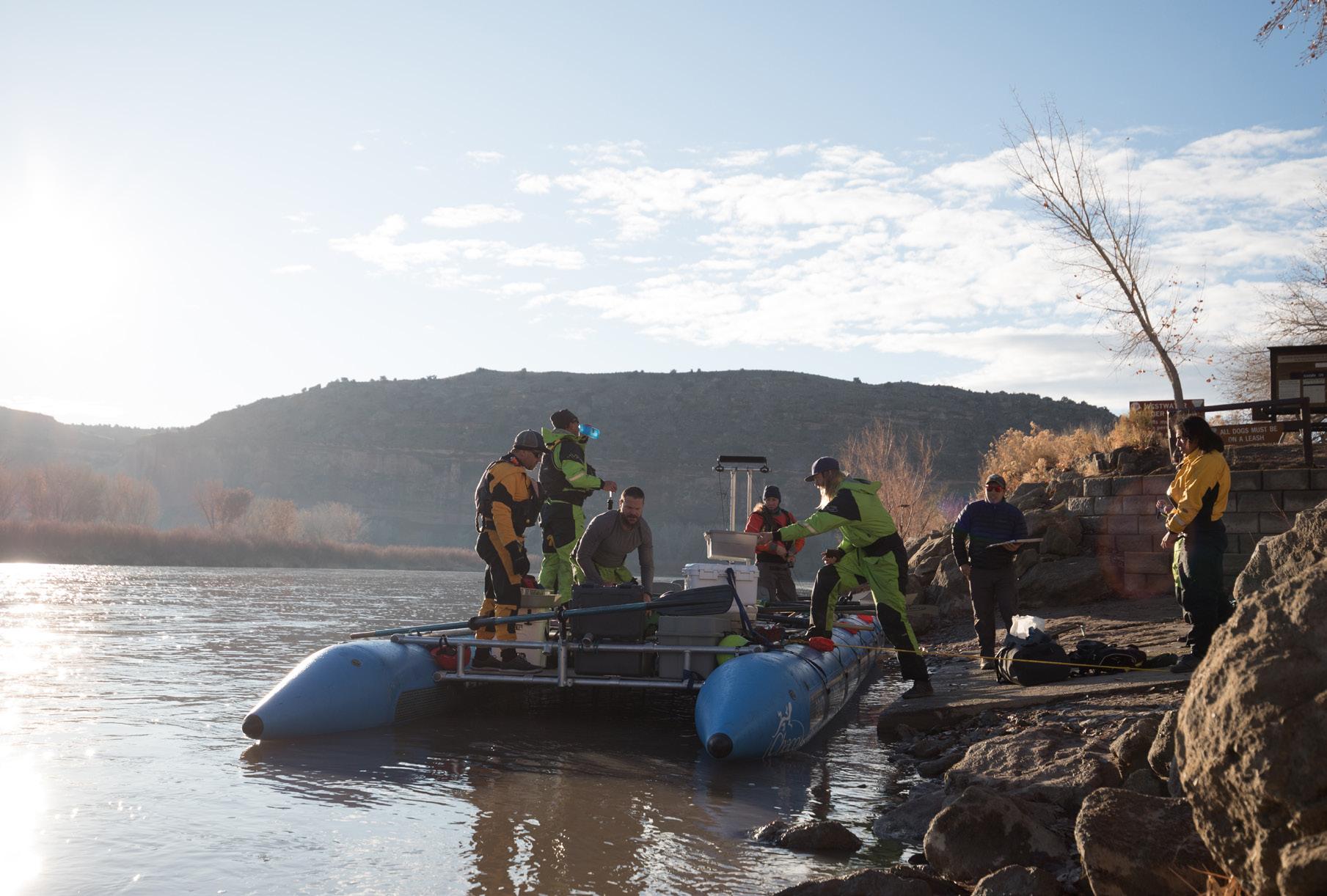
31 minute read
US MEN’S RAFT TEAM
TEAM PROFILE
THE 9-BALL WATERMEN
Advertisement
CAPTAIN JOHN MARK SEELIG + THE U.S. MEN’S WHITEWATER RAFTING TEAM
Words by Lexi Reich | Photos by Robbie Prechtl
The U.S. Men’s Whitewater Raft Team, based in Vail, Colorado, is comprised of six men: Robbie Prechtl, Jeremiah Williams, Matt Norfleet, Kurt Kincel and John Mark Seelig, the team’s captain.
The team has been in the valley for over 16 years, and the current lineup of men has been together for almost eight, forming their clan in 2013.
“We’ve grown incredibly close over the years. We’re just like brothers; we fight like brothers; we work with each other like brothers; we’re there for each other through multiple life stresses and struggles,” shares Seelig. “And, you know, suffering with other people in the Grand Canyon for 38 hours … that’s a pretty big bonding moment.” 37 hours and 55 minutes to be exact.
This past January, the team and three experienced raft guides embarked on a mission to row 277 miles down the Grand Canyon in less than 34 hours, attempting to break the world record set by kayaker Ben Orkin in 2016.
“It’s always nice having some other eyes and viewpoints in the boat. These guides have been down the canyon more than 150 times,” he says of the three long-time guides that helped take over some positions.
Three years earlier on January 13, 2017, the team had attempted to break the same record.
Their pace put them two hours ahead of schedule, but they were met with a broken raft at Lava Falls, one of the world’s most notorious whitewater rapids. It took four hours in the dark to repair the damages. Their journey was featured in the documentary The Time Travelers.
But, January 9, 2020 was a different attempt.
“We knew breaking the record was going to be harder this time,” says Seelig, explaining how there are many things in this sport that are out of the team’s control. During their first attempt in 2017, the river was close to 19,000 cubic feet per second (cfs), referring to the volume and speed of water flow. This time it was 10,000 cfs.
Seelig says the team knew about four days before the attempt that the likelihood to break the record was not in the cards, but they didn’t realize how low the river was until they were actually in it.
“We’d been training and still wanted to have the experience, and we just went for it,” says Seelig. “We didn’t let up; we’re not those kind of people — it’s the most positive peer pressure. We all went hard for 38 hours.”
“There’s this moment where you don’t want to let anyone else down. You think, ‘I need to do this with these guys,’” he adds.
Temperatures were in the 20s, and their toes were getting splashed the whole time. They said it was the coldest they’ve ever been. Despite Norfleet suffering from frostbite on his toes, the team and their revamped boat design completed the mission, not in record-breaking time, but together, as a team.
“We didn’t want to just walk away with ‘oh that happened,’” explains Seelig. “We wanted to raise money for a cause we believed in.”
The U.S. Men’s Whitewater Raft Team raised $13,000 for Grand Canyon Youth, an organization that gets kids on the river and exposed to ecological and environmental issues pertaining to the needs of the Grand Canyon and other national parks.
The team, which officially changed its name to 9-Ball Watermen in 2017, participates in not only international rafting races, but also in feats such as the one in the Grand Canyon.
“USA National Rafting Team doesn’t tell the whole story,” Seelig shares. “We wanted to look beyond raft team championships and races across the world, and, instead, trying other endeavors and challenges that are on the water — from outrigger canoe paddling, Grand Canyon speed runs, kayaking and paddle boarding.”
Just an hour after the Grand Canyon speed run, Seelig was asked what was next for the raft team. Right now, they’re going to catch their breath and have a team meeting to go over their future goals — maybe a race in Chile next year on the Futaleufu River or a long distance kayak experience.
And, until then, you can find the team training in Seelig and his wife’s gym, GOAT, located in Edwards. The strength and conditioning facility is designed for professional athletes and recreational folks alike.
“The gym provides a space where people can almost have a personal training type experience, but in a group setting,” explains Seelig. “With that group setting, people are inspired by each other, and they push each other. It builds a fantastic community.” :
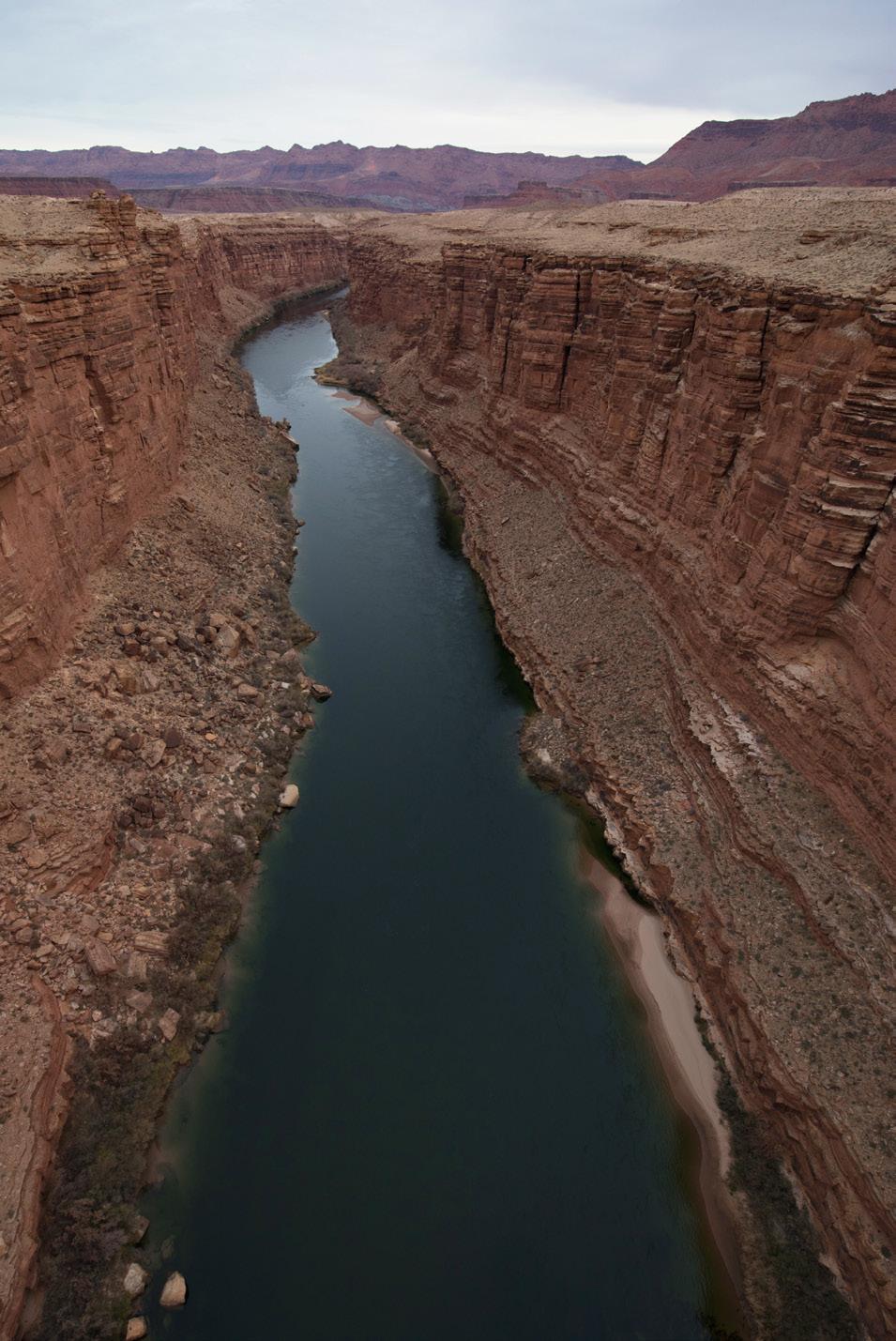
CHILDREN + THE OUTDOORS
Words by Abram Herman | Photos courtesy Friends of Youth and Nature

At 8 years old I was slogging my way up the trail behind my parents, tired and grumpy. I hate hiking, I thought. Why would anyone want to walk uphill for hours for no good reason? I could be watching TV right now. Finally we reached the top. Out came the food we’d packed, and as we sat on a peaceful summit admiring the view and enjoying our hard-earned lunch, I realized how much better it all tasted because of the work we’d just put in. Maybe this “hiking” thing wasn’t so bad after all.
Many Colorado residents enjoy hiking, mountain biking, skiing and other activities that get them outside and breathing hard in the fresh air. It’s a way to stay fit, and even more than that, it’s an important part of maintaining happiness and mental health. But what impact does an early introduction to the outdoors have on who a child will become as an adult? How are they affected physically, mentally, emotionally and even morally? As it turns out, we can directly connect childhood exposure to outdoor activities with long-term outcomes.
PHYSICAL FITNESS
It’s no secret that children are frequently neglecting more physical, outdoor forms of play in favor of the digital world — reducing
kids’ screen time is often a major struggle for parents in the modern age. Computers, mobile devices and video games are passive forms of entertainment, and they don’t call for physical coordination, strength, endurance or any of the other attributes necessary for a healthy body. Outdoor play, on the other hand, promotes all of these things and is a natural method of encouraging physical activity in young people.
A 2015 meta-analysis published in the International Journal of Environmental Research and Public Health regarding the effects of time spent outdoors on children found that “outdoor time is positively related to physical activity and negatively related to sedentary behavior in children aged 3 to 12 years.” The more outdoor time children have, the more physical activity they take part in and, conversely, the less sedentary behavior they display.
EMOTIONAL WELL-BEING
Many people spend time in the outdoors because it brings them a sense of happiness and wellbeing. The natural environment is certainly more conducive to good mental health than the bustling and overwhelming stimuli of the city. If adults who have grown accustomed to the ways of the modern world still need to get away to nature every now and then to stay happy, surely children must benefit from these quieter natural spaces as well.
Perhaps unsurprisingly, a 2018 study in Preventive Medicine showed that the more time children spend in nature and the greater sense of connection they personally feel with nature, the less likely they are to experience psychosomatic symptoms such as irritability, anxiety, difficulty sleeping, headache, stomach ache, backache and other physical afflictions. The benefits start with as little as 30 minutes of outdoor activity per week.
STEWARDSHIP
Physical activity, cognitive development, emotional well-being — these things are relatively easy to quantify in research. But what about something like an individual’s moral drive to preserve our natural areas, or their innate desire to be good stewards of the land? Can we quantify these outcomes?
Though it’s more difficult to show a correlation between time spent in the outdoors during childhood and an individual’s likelihood to become a good environmental steward, it has been shown that the amount of time spent in the outdoors has a direct correlation with a child’s feelings of connection with nature. According to 2011 research at the University of Massachusetts Amhurst, this sense of connection with the natural world then has a direct influence on behaviors related to environmental stewardship in children such as “conserving water, turning out lights, recycling, talking about the environment and picking up litter.” The more time we can get future generations to spend in the outdoors, the greater sense of connection they’ll feel with nature, and the more likely they will be to work at environmental stewardship and preservation.
So the next time you take your kids outside, know that you’re not only directly contributing to their physical and mental well-being — you’re also helping to raise a generation that will value our natural environment and ensure the preservation of outdoor spaces for years to come. :
CELEBRATING OUR 1-YEAR ANNIVERSARY AS MESA COUNTY'S FINEST REAL ESTATE COMPANY 970.589.7700 | christireece.com

FAMILY BACKPACKING 101
Words by Kristen Lummis | Photo by Hayden Hogoboom
Ask Heather Hogoboom about family backpacking and her voice fills with enthusiasm.
“Of all the things we do together, our annual backpacking trip is what we look forward to the most,” shares Hogoboom, who began backpacking with her husband Pat when their sons were between the ages of 12 and 18.
Hogoboom, a Grand Junction native who now makes Summit County her mountain basecamp, has backpacking experience dating to her first years out of college. But when her children were little, the focus was more on car camping.
“As the boys got older, we realized that backpacking would be a great way for us to do something together and to create a new family tradition,” she explains.
Family tradition is what drew another mom, Ann Leonard of Grand Junction, to backpacking. Leonard has been backpacking since she was 6 years old. When her daughter, Zia, turned 6, Leonard and her husband Ryan decided she was ready to follow in the family’s footsteps.
For her first trip, the Leonards journeyed to Ice Lake and Island Lake near Silverton. “This area was the spot of many of my childhood backpacking trips, so it was special to take her back there, especially since my dad and brother joined us,” explains Leonard.
Today, the Leonards are a backpacking family of four, with 5-year-old son Koen joining in.
KEYS TO SUCCESS
Whether you are backpacking with young children or teenagers, Hogoboom and Leonard share these keys to success. n Start with day hikes. Make sure your kids can hike with a day pack and carry their own water. n Plan for success. Keep your first family adventure short and enjoyable. “Our first trip was just three miles in,” says Hogoboom, adding that the elevation gain wasn’t extreme.
“We wanted them to enjoy it and go again.” n Involve kids in planning. Kids can read trail reviews, help apply for any necessary permits and assemble gear, including fun things like cameras, binoculars, cards and dice games.
They can also choose (and carry) their favorite backpacking foods. n Pack smart. Hogoboom and her family take two
Jet Boil stoves for six people. Other necessities include two water filters (in case one has issues) and clothing layers: extra socks, a waterproof hooded jacket, base layers and a fleece or puffy. “Otherwise, just go very simple,” she advises. For guidance on packing, Hogoboom suggests searching online to learn how to pack a backpack. “It makes a difference.” n Follow the 50-10 rule. Leonard swears by the hiking strategy her parents used with her.
“Basically, it’s hike for 50 minutes, stop for 10,” she explains. Because her kids know a break is always coming, it helps keep other stops to a minimum. n Snacks and games. Snacks are a must, as are trail games. Leonard shares that she has great luck with story-telling, I-Spy, alphabet games and “I’m thinking of” games. As she puts it,
“Distraction helps!” n Leave no trace. Disconnect, enjoy the peace and quiet, the laughter and the memories you’ll build together. But, always respect the wilderness and follow “Leave No Trace” principles.
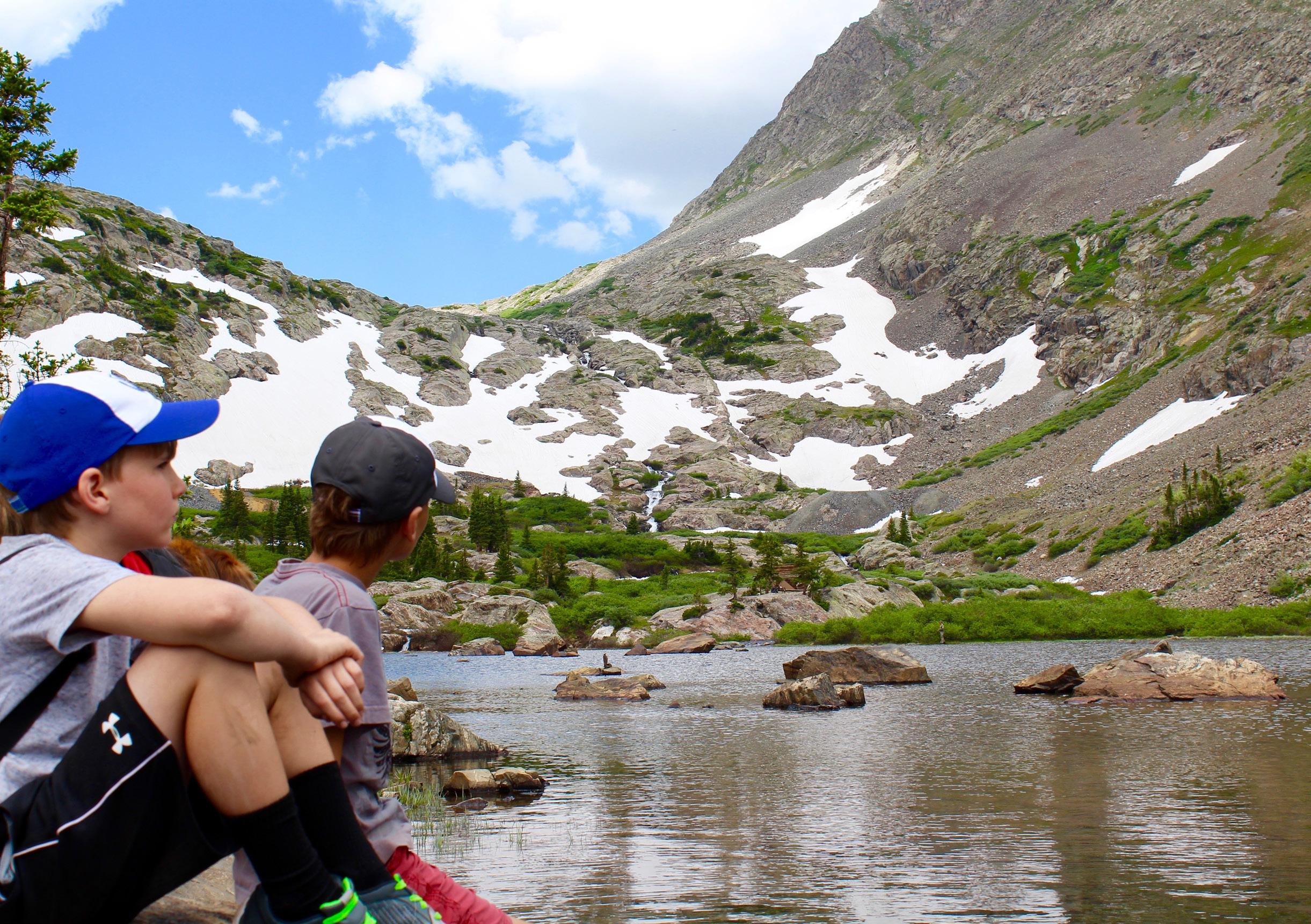
EASE AND MEMORIES
While it may seem surprising, Hogoboom is convinced that backpacking is much easier than car camping.
“The logistics are so much easier,” she laughs. “Car camping takes a lot of time loading and unloading. Backpacking takes more prep time, but then we just put on our packs and go.”
Once in camp, Hogoboom explains that each member of the family has a job to do. Maybe one son looks for level places for tents, while others set up the cooking area, filter water or hang hammocks. Then, when everything is in order, “we kick back and enjoy our weekend.”
Leonard and Hogoboom agree that uninterrupted family time in the wilderness is one of the most important benefits of backpacking.
“I love sharing something that I love so much with the most important people in my world,” explains Leonard.
The lack of modern distractions leads to better conversations and forces her children to play with one another. “They are always better friends when we return from a trip,” Leonard adds.
For Hogoboom, family backpacking has bonded the brothers and their parents together through pristine bluebird days and torrential, mud-filled slogs.
“We get through the little travails and the end result always makes it worth it,” she reflects.
Similar to many aspects of life, family backpacking may challenge you and your family, but it will also help you grow together.
Enjoy! :

RABBIT VALLEY
MCDONALD CREEK CANYON
Words + Photos by Melanie Wiseman

West of Grand Junction and just shy of the Utah border lies Rabbit Valley and McDonald Creek Canyon — an extraordinarily scenic, historic and protected trail. Located in the McInnis Canyons National Conservation area, the Bureau of Land Management (BLM) designated the canyon and land in proximity to it as the McDonald Creek Cultural Resource Management Area, in order to protect both the fragile, prehistoric archaeological sites and the canyon which was home to the resourceful Fremont Indians.
The BLM wants visitors, today and in the future, to experience McDonald Creek Canyon just as the Native Americans did. For this reason, only foot traffic is allowed and hikers are encouraged to walk in the stream bed as much as possible to prevent the development of trails. Dogs are welcome, camping and campfires are not.
This easy trail can vary in length between 3 to 4 miles depending on your choice of hiking the main route to the Colorado River only or including side canyon scrambles. Four panels of rock art (three pictographs and one petroglyph) can be seen between the trail head and the mouth of the canyon.
The first rock art panel is approximately 1/4 mile down the stream bed from the parking area on a west-facing cliff about 15 feet up, prior to the stream bed to canyon transition. After another 1/4 mile the canyon narrows and takes a sandstone-sculptured drop-off carved by years of creek runoff. Follow the cairns for a short slickrock bypass, bringing you back to the stream bed and a view of the next two panels — one on either side of the canyon. The last panel is high on the wall of a large alcove 1/4 mile before the Colorado River. It’s helpful to bring binoculars to see the detailed art — attempting to climb up to them could damage yourself as well as the art.
Late spring and early summer are the perfect times to enjoy this free, family-friendly hike, when a multitude of cacti and desert wildflowers display their splendor. McDonald Creek Canyon can be enjoyed yearround, but avoiding the summer heat and taking plenty of water is advised. Higher clearance vehicles are recommended but 4WD is not required. :
n From Grand Junction, travel west on I-70 and take the
Rabbit Valley Exit #2. n Turn left and go south over the interstate, continuing on the dirt road. n Go right at the first turn and left at all other junctions. n The trail head parking lot and facilities are located 2.5 miles from the interstate directly across from a sizable rock formation that looks similar to a large gumdrop.
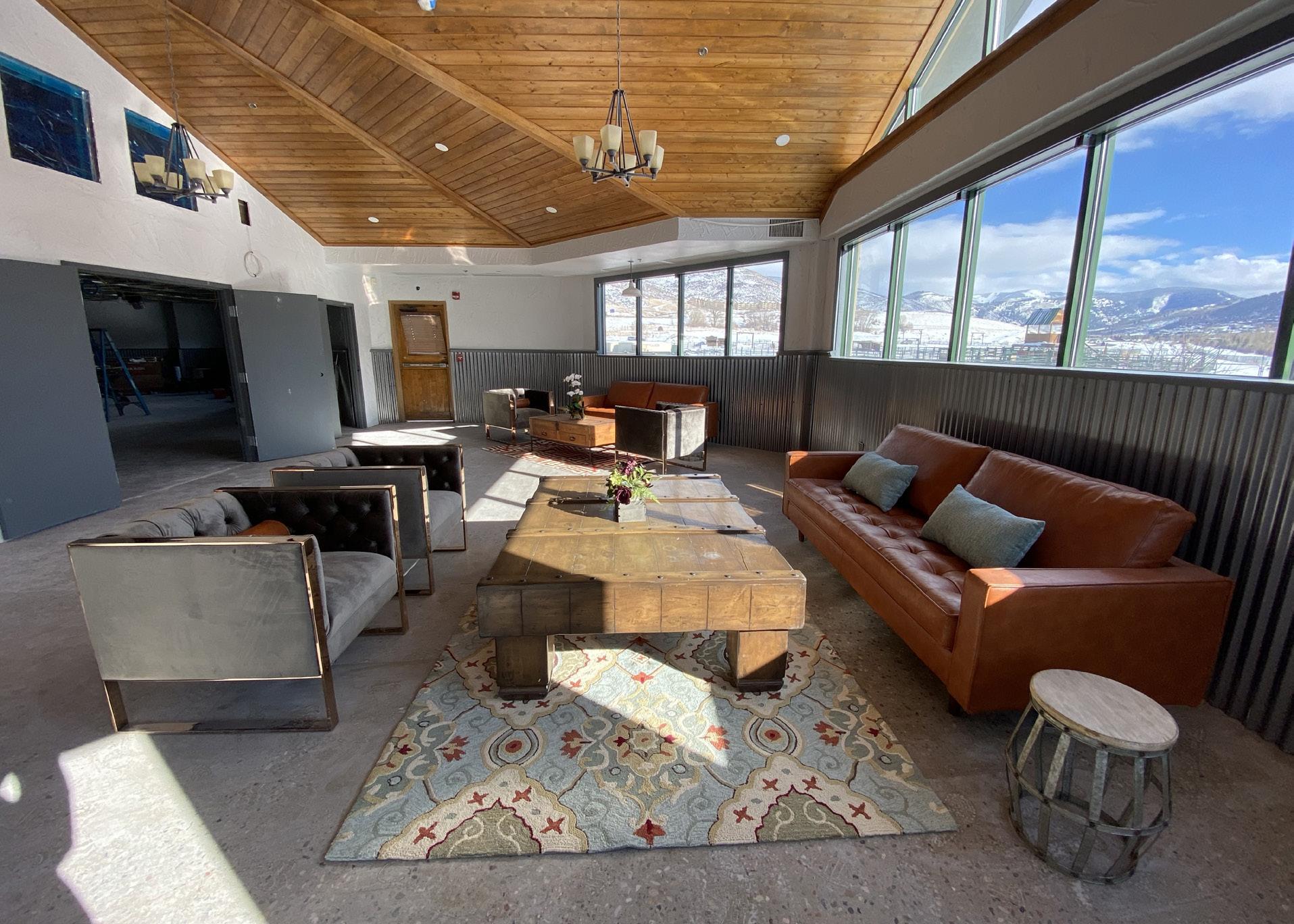
AVON, COLORADO COHABIT PODTEL
Words by Bobby L’Heureux | Photos courtesy of Cohabit Podtel
When you think of staying in Vail or Beaver Creek, affordable is not the first thing that comes to mind. Bret and Carryn Burton set out to change that with the Cohabit Podtel. After many years spent in the Vail Valley working in the restaurant and hotel industries, Bret and Carryn have been in real estate for some time now. For the past few years they have been kicking around the concept that had become Cohabit Podtel, and finally their dream has become a reality.
“We love to travel and have stayed in dozens of hostels all around the world. We always choose hostels over hotels because it is a better experience and we enjoy meeting and socializing with other travelers,” Bret says. At the same time, they found staying in the bunk rooms was a little too connected to the other travelers. They often opted for the private room so they could get the best of both worlds. When coming up with the concept for Cohabit Podtel they took all of their travel likes and dislikes to nail it down.
“We began brainstorming ideas to bring hostel-style lodging to our community, but with a solution for private sleeping quarters. After months of trial and error, we settled on the pod concept and Cohabit Podtel was born,” Carryn shares. “We knew the Vail Valley needed affordable accommodation and we wanted to take our knowledge and experience from decades in the hotel and hospitality industry
and combine it with our passion for travel and customer service.”
Cohabit Podtel is the first of its kind in a mountain town. They are trying to break the mold of traditional lodging to bring guests a unique and affordable alternative to the high-priced resort accommodations that currently exist. They created the same relaxed, social feel of a hostel with the privacy of a boutique hotel. There is only one private room at the Cohabit Podtel. The rest are custom built, private sleep pods. The Burtons worked closely with HMR Construction out of Edwards and Tiny Home Connection out of Denver to complete the concept.
If you are like many adventurers when you travel, all you really need is place to rest your head and store your gear. Each sleep pod can accommodate two guests in their own private space, thoughtfully appointed with charging outlets, reading lights, luxury linens and mobile smart locks. The sleep pods are noise insulated with eco-friendly recycled denim and are well ventilated to ensure maximum guest comfort.
The goal of the Cohabit Podtel is to cater to those who value adventure over luxury. “We strive to bring travelers, outdoor enthusiasts and adventure seekers together to enjoy our community’s world-class activities,” Bret says.
Cohabit Podtel offers minimalist accommodations and strives for exceptional guest service, along with all the amenities you need for your next adventure. With a fullon locker room as well as locking storage for you gear, you are only a few steps away from everything you need to get outside and play.
There is a spacious lounge with sweeping mountain views and a fireplace in the lobby that provides a perfect place to mingle with likeminded travelers. Cohabit Podtel boasts seven private shower suites and communal restrooms, as well as a coffee bar and work nook. There are plans to acquire a liquor license in the near future.
There is free onsite parking and high-speed WiFi. They have state-of-the-art door locks that allow guests 24-hour mobile access. Guests are able to check in with their smart phones when arriving before or after hours. Their location in the heart of Avon provides access to several restaurants, shops and amenities all in walking distance. There is access to the skier shuttle or in-town bus just outside the establishment.
“Whether you are enjoying the great outdoors in the summer or winter, spend your time and money doing the things you love — we will take care of the rest,” says Carryn. “Our brand embodies the spirit of Colorado and the promotion of outdoor recreation.”
The Burtons have a goal to expand the concept throughout Colorado, primarily in ski towns. They want to be recognized and trusted by anyone visiting their establishment and our beautiful state. :
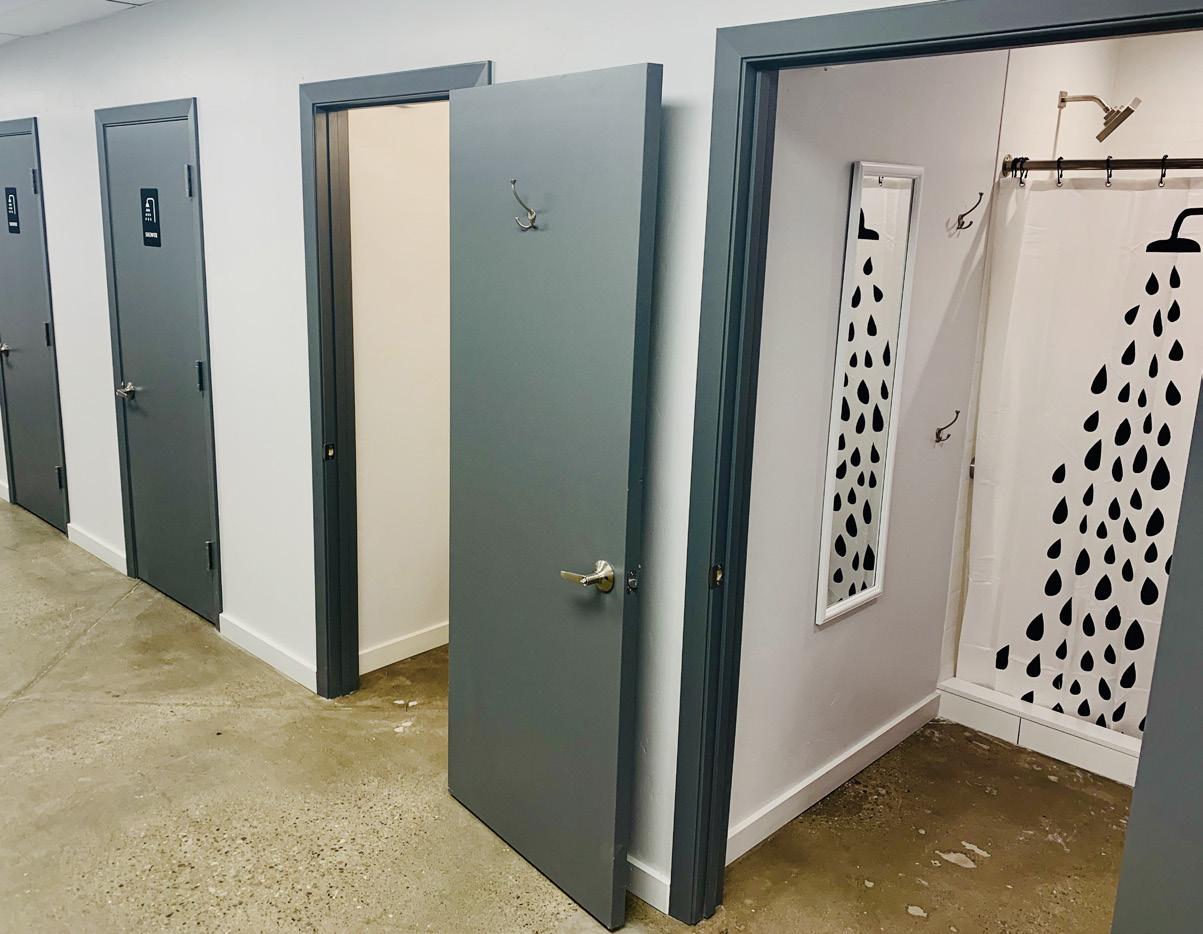
For more information go to cohabitpodhotel.com

COURTESY FENCELINE CIDER
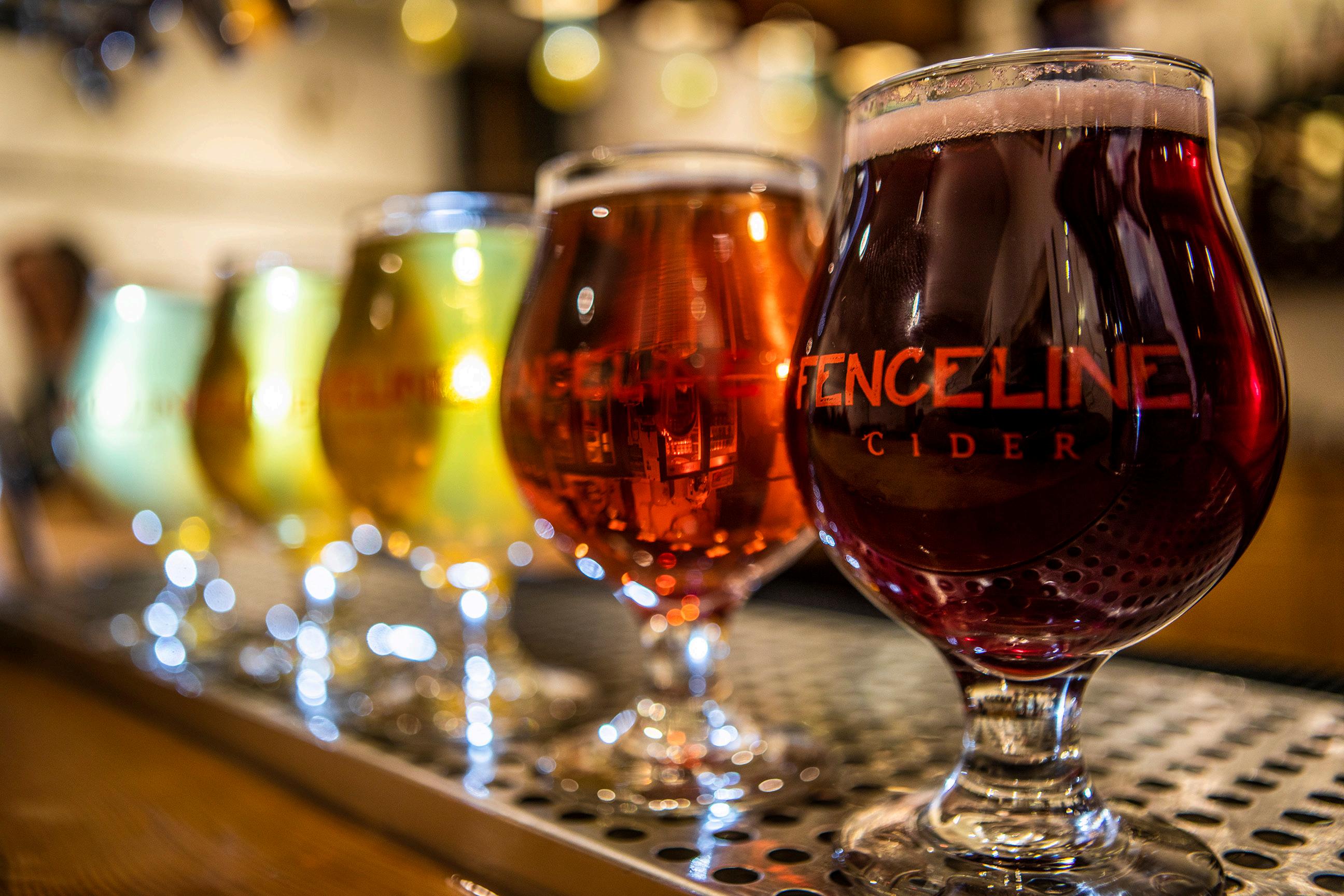
MANCOS, COLORADO WHERE ART MEETS AGRICULTURE
Words by Katherine Peach | Photos courtesy of Steve Fassbinder, Mancos Creative District
Plenty of time outdoors feeds a certain type of creativity. Mancos offers this type of creative inspiration by the pound thanks to its unique intersection of growers, makers, ranchers and outdoor recreation opportunities. This small community, previously overshadowed by larger neighbors, is worth a weekend stay for anyone looking to explore arts, adventure and a growing food scene in the Southwest.
FRIDAY: MANCO’S CIDER TRADITION
The first stop is Fenceline Cider’s riverside taproom. The family-friendly gathering space is fostering a sense of community with live music, food trucks, an outdoor patio and drinks over a board game. Stimulating the Southwest’s forgotten apple industry, Fenceline founders Sam Perry and Neil Wight use heirloom varietals dating back 100 years. The name is a nod to the region’s many wild apple trees growing as a result of birds dropping seeds while sitting on fence lines.
“Southwest Colorado is unique because we have varieties no one is working with,” says Sam Perry, Fenceline co-founder. “We have varieties that have been propagated by the birds. They are essentially mutts.”
Reviving this forgotten economic driver, the founders convinced local ranchers to sell apples from trees forgotten and unused on their property. Now selling nationwide, visitors will find 10 rotating ciders and wine on tap. Don’t miss the Pollinator, a rose-inspired cider, ideal for sipping on a warm day, and Fenceline’s signature Seedling, a modern American cider.
Sourcing from nearby growers speaks to the town’s larger heritage of perseverance and determination.
“Mancos is the type of place and type of people who believe it can be done,” says Sara Syverson, a local artist and producer.
Syverson shares how Mancos benefits from collaboration between farmers and artists as a result of a “can-do” attitude within the community. Whether sourcing unused apples or finding land for outdoor theatrical installations, such as her one-time production of the Purple Fox Conundrum last fall, putting creative ideas into action can be as simple as thinking outside the box about the wealth of natural resources found in the area.
A mover and connector, Syverson calls the intersection of agriculture and arts a gift to Mancos. There is still a space here for art. Check out local art and events at the taproom, such as the Raven Narratives, a Moth-style event presenting live true stories at the taproom.
SATURDAY: WALK THROUGH HISTORY
The Mancos Creative District spans several downtown blocks of galleries, businesses and several buildings from the late 1800s to 1900s. Historic walking tour maps are available at the kiosk on the corner of Main and Grand Avenues or from the Chamber of Commerce. The maps direct visitors to 18 locations, including the restored Bauer House built by the town founder in 1890.
Head to the former Mancos Times-Tribune building on Grand Avenue, now the Mancos Common Press. The restored letterpress design and print studio doubles as a museum, with equipment and newspaper archives dating back almost 140 years. Printing workshops are also taught onsite by a local artist through the nonprofit Mancos School of the West.
Downtown is also host to several artists cooperatives: Artisans of Mancos, Raven House Gallery and The Painted Turtle Studio, a community center featuring art for sale and a studio where visitors of all ages can make ceramic artworks. For authentic western items, Kilgore American Indian Art houses a collection of rare Native American rugs, pottery and jewelry. Visitors can easily spend the day visiting boutiques, so fuel up at Absolute Bakery & Café on Main Street.
After risking being condemned, Mancos Opera House was rehabilitated as a theatre and arts hub by efforts spearheaded by residents Philip and Linda Walters. Listed on the National Register of Historic Places, the ground floor served as a drug store and butcher shop, while the second floor of the opera house provided a place for cultural pursuits, including the first motionpicture theater in the county and a ballroom.


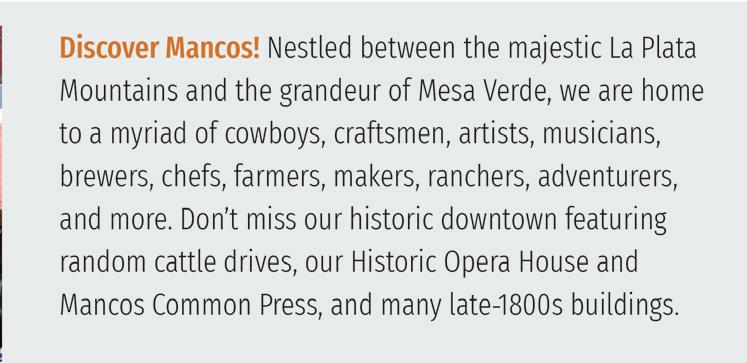

Mancos 101
n Mancos is about a 4-hour drive south of Grand Junction, and is located between Dolores and Durango.
n LODGING Willowtail Springs visitors can enjoy private lakeside cabins, including the Bungalow, with space for up to four people. Opening for the season in May, Echo
Basin offers rustic A-frames, larger cabins and an RV park on its forested grounds. Each are located six miles from downtown Mancos.
n BREAKFAST + LUNCH Operating as a family-owned business since 2007, Absolute Bakery & Café sources local ingredients and bakes bread in-house for lunch and breakfast. Grab take-away at Fahrenheit Coffee Roasters and Zuma Natural Foods — sandwiches, soup and natural grocer options.
n DINNER Visitors will find elevated dining and art at
Olio, featuring a weekly menu based on local available ingredients and a new local artist on the walls every other month. Mancos Brewing Company has rotating craft beers brewed onsite and a small menu using ingredients sourced from local farmers. Ideal for a nightcap, the Columbine Bar is a down-home bar on
Grand Avenue, established in 1910.
n EXTEND YOUR STAY Nearby archeological sites and world-class bike trails attract outdoor enthusiasts and history buffs alike to the region. Plan ahead for your visit to Mesa Verde National Park, as certain sites are accessible only through ranger-guided tours, including the Cliff Palace, which opens for the season April 12.
The historic building is scheduled to open to the public for the presentation of “The Blacksmith,” a comedic opera composed in 1762. Speaking to the region, the May 2 and 3 performances integrate folk songs and audience participation. Even without seeing an opera, it’s worth a look inside the place where two ranchers took a leap of faith in 1910 to build a community space in a small western town.
SUNDAY: SEEK OUTDOOR ADVENTURE
For the final day, choose your own adventure (depending on the weather) in the desert. While night skiing at the mom-and-pop Hesperus Ski Area closes in early March, sister mountain, Purgatory Resort, near Durango, allows for daytime skiing from its 11,000-foot summit through mid-April.
Alternatively, starting in late April, decent snowpack and warm temperatures equal opportunities for a scenic float down the Dolores River, one of the longest-flowing river canyons in the country. Local outfitters can provide gear and guidance. For the self-led option, use one of the ultra-light inflatable Alpaka Rafts handcrafted and sold in downtown Mancos. The brand also released the two-person Oryx, a packraft canoe ideal for McPhee Reservoir’s flatwater. :

Mark Waltermire in front of his farm
CONFRONTATION IN COLORADO’S FARM-TO-TABLE CAPITAL
Words + Photos by Lexi Reich
Mark Waltermire has been tending goats and chickens at his farm, Thistle Whistle, in the lush North Fork Valley for 15 years. He grows 180 varieties of heirloom tomatoes and plans to expand his diverse vegetable orchard to offer even more options to Coloradans interested in eating better quality food. It’s a lifestyle shared with many people in the state’s farm-to-table capital.
For years, scores of organic farmers in the valley have organized to protect their natural resources, including the critically important North Fork of the Gunnison River, from oil and gas development. Together the community developed the North Fork Alternative Plan. Born in 2013, the plan suggested reducing the amount of public lands available for fracking, and that drilling wells should be at least a half-mile from the municipal water supply, among other things.
But now a move by the current administration has folks up in arms, as they fear potential crosscontamination from fossil fuel development. Known as the agricultural hub of Colorado, the North Fork Valley communities of Crawford, Hotchkiss and Paonia blame the Bureau of Land Management’s (BLM) proposed Uncompahgre Field Office Resource Management Plan for threatening their livelihoods and reputations. The community is raising its voice to protect their farmlands, clean water supply and air quality from pollution.
It has been an uphill battle. Last March, U.S. District Judge Lewis Babcock agreed with conservation groups in Paonia that the federal government’s proposed oil and gas drilling plans, which would’ve drilled 175 gas wells in the valley, fell short in studying the indirect
impacts of oil and gas production on the people and the land.
Three months later, last June, the BLM announced a revised plan, known as Alternative E. It promises $2.5 billion in total economic output to the region, supporting up to 950 jobs over the next 20 years. How? By opening 95 percent of public lands in the North Fork to oil and gas development.
Eric Carlson, executive director of West Slope Colorado Oil and Gas Association, which represents the region’s oil and gas companies, explains that the new proposed Resource Management Plan has undergone processes analyzing the environmental impacts of resource extraction in great detail. He says the public can comment, interact and intervene upon it as much as they want to.
But that doesn’t mean the government will accommodate, according to Waltermire and others.
Most importantly, Alternative E ignored the community-developed North Fork Alternative Plan, which was scheduled to be approved or denied last October, but a decision has yet to be made.
“I was surprised at the extent of how it didn’t reflect our interests,” said Waltermire. “I go back and forth between being angry and feeling a little helpless at my ability to influence it.”
While milking his goat Lucy, Waltermire said farming has been a part of his family for generations. “It allows me to live a life that feels like I have the opportunity to be more responsible about my lifestyle choices. Growing my own food, providing food for others and integrating education into that makes me feel like I’m less a part of the problem and, perhaps, offering a solution,” he said, standing up with his basin full of milk. “Come on, Lucy!”
The people and the economy of the valley are closely connected with the region’s natural resources. Once shaped by coal mining, the rural valley has moved towards a more sustainable and diverse economy, with agriculture being a major player, especially within the last decade, according to the Center for American Progress, a nonpartisan policy institute.
Many community members and activists argue there are environmental and economic concerns from proposed oil and gas drilling; mainly, the threat of oil spills.
The North Fork is along Highway 133, a slim two-way mountain road with no shoulder, and a lot of rockslides and fragile soil. You can hear the buzz of cars from Thistle Whistle.
It’s not unlikely for a truck to get in an accident and contaminate water as oil spills downstream. The chemicals could go into irrigation ditches the farms and wineries of the North Fork depend on. These pollutants would also affect the Colorado River Basin states.
“It’s really inappropriate for the highway to have that kind of overwhelming truck traffic. Those trucks are not carrying peaches, but fracking sand and chemicals and all sorts of things we don’t want spilled into our river,” Waltermire said.
The consequence of the spills extends beyond measurable contamination — it’s the reputation that’s soiled, he adds.
“It’s already difficult enough to convince somebody to make a four-and-a-half-hour,
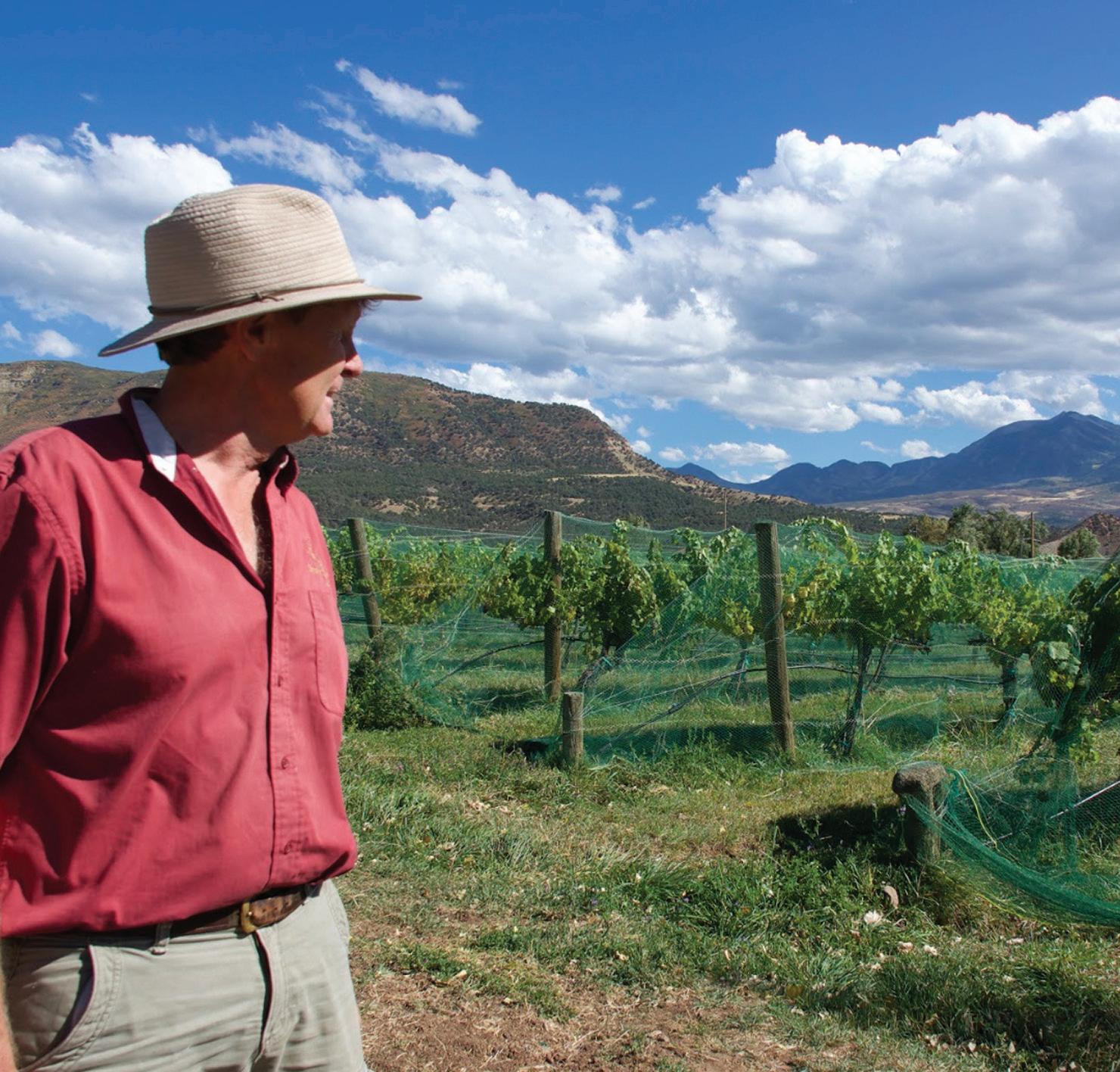
Brent Helleckson of Stone Cottage Cellars gazes at his winery. He has water rights that date back to 1884, and is fearful contamination from fossil fuel development will threaten not only his grapes, but the ambiance of the valley as a tourist destination.
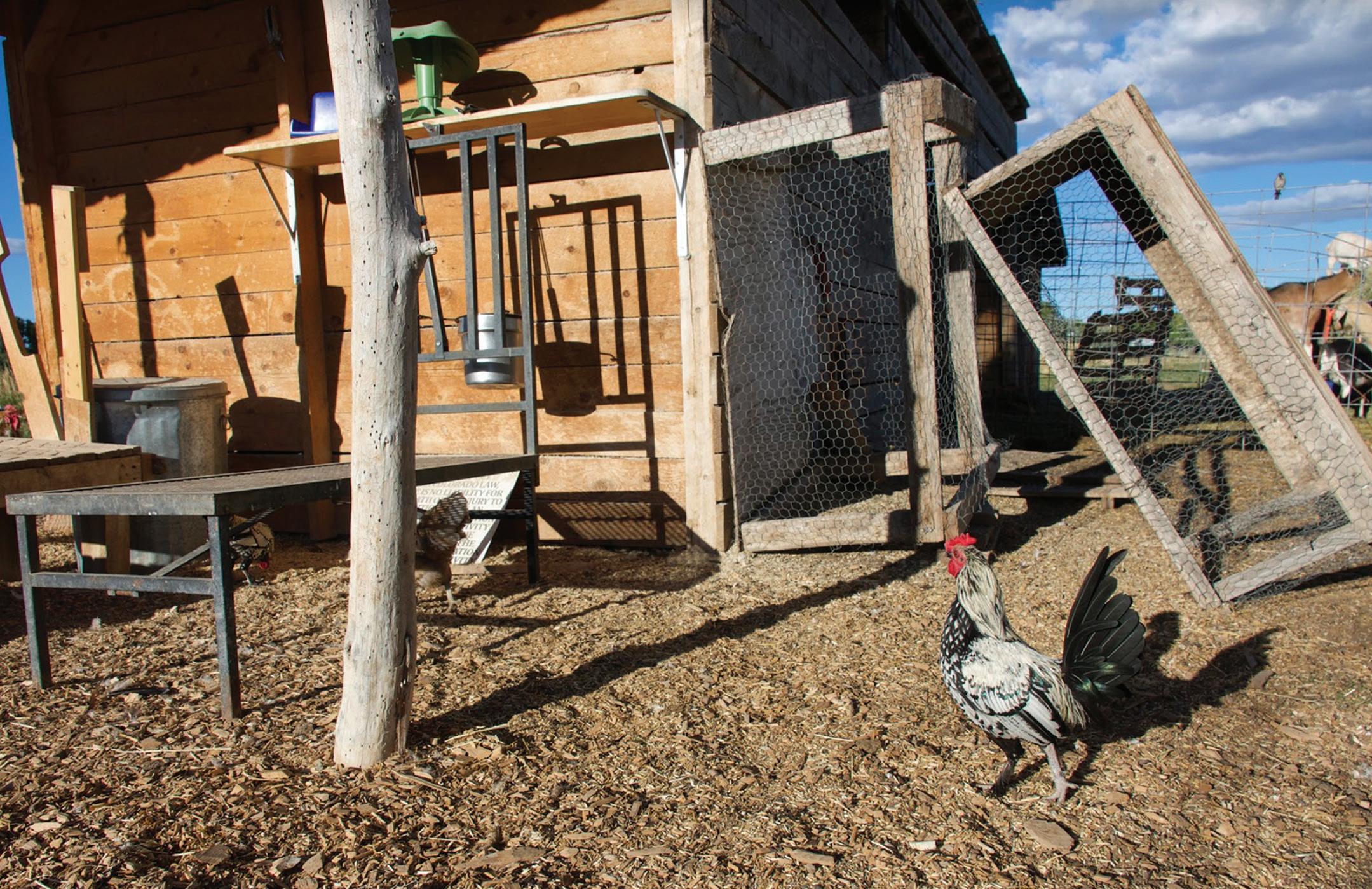
“I don’t get bored of this work. I get to work outside. I get a variety of physical and intellectual challenges. Philosophically, I feel like it allows me to live a life that feels like I have the opportunity to be more responsible about my lifestyle choices. Growing my own food, providing food for others and integrating education into that makes me feel like I’m less apart of the problem and perhaps offering a solution,” says Mark Waltermire, owner of Thistle Whistle farm in Hotchkiss, Colorado.
five-hour drive from the Front Range to come over here and enjoy themselves in this area,” said Brent Helleckson, 60, owner of Stone Cottage Cellars in Paonia, a family-run winery. “If I have to get them to come through an oil and gas field in order to do that, it makes it much more difficult.”
Helleckson has water rights on his property that date back to 1884, and he resists leasing to the oil and gas industry. He says land close to nearby irrigation ditches, like Terror Creek Ditch, are being explored for leasing. “It seems very foolish,” he said.
Rich Rudin of Terror Creek Ditch declined to comment.
Jim Ramey of The Wilderness Society says many restaurants along the Front Range advertise that their ingredients are from North Fork Valley farms. He believes one oil spill could contaminate the reputation of Colorado agriculture.
A report by The Wilderness Society on the current administration and fossil fuel development from July says, “Our public lands and waters are supposed to be managed in the public interest and should play a leading role in our fight against climate change. But under this administration, management decisions are only accelerating the climate crisis.”
We are already seeing the impacts of climate change: models are predicting a hotter and drier future, a big challenge for farmers to cope with where there are even more limited water supplies, says Patrick Dooling, executive director of the Western Slope Conservation Center. Adding the environmental concerns of oil and gas drilling is disturbing to the North Fork and across the West.
“It really decreases our opportunities to market ourselves as this organic, natural, agricultural area,” said Dooling, gazing at the Paonia River.
Fossil fuel development is known to be water-intensive, supposedly using millions of gallons of water, and, once used, is often polluted and not able to be recycled for other purposes,
or is pushed deep into aquifers, making it unavailable in our lifetime or our children’s, according to Dooling.
Emily Ibach, state affairs director at the Colorado Farm Bureau, disagrees: “Largely, we don’t see many issues with water after it is used for oil and gas production. There are limited uses for that water, but sometimes farmers are able to utilize it or it will be filtered and released into the rivers to be used by downstream users.” In fact, she says the oil and gas industry supports the agriculture industry, providing monetary incentives to farmers and ranchers who lease their land and water rights to the industry.
In 2017, state data shows oil and gas spills increased in Colorado, with reports of chemicals flowing directly into waterways. However, the Colorado Oil and Gas Conservation Commission spill analysis shows spills decreased in 2018. Yet, of all spills reported in 2018, 410 were within a half mile of a water well.
Dooling explains that by looking at other oil and gas producing basins across the world, development, overall, typically comes with increased air pollution and water contamination. In Wyoming, data from the Wyoming Oil and Gas Conservation Commission revealed an average of nearly two spills per day in 2018.
“If we’re going to allow leasing, we have to make sure that if oil and gas activity occurs, folks are protected from these potential problems, and they didn’t do that,” said Waltermire. “The two private companies that have the leases above us in our watershed are playing economic games that I don’t get.”
In a press release with the announcement of Alternative E, the BLM wrote they considered community input in formulating the new plan, which they say responds to “local community needs, while aligning with administration priorities, like public lands access, sustainable energy development, economic growth and conservation stewardship.”
It appears only time will tell what is to come of the diverse landscapes of lush greenery, rocky desert land and mountain ranges that compose the Nork Fork Valley. :
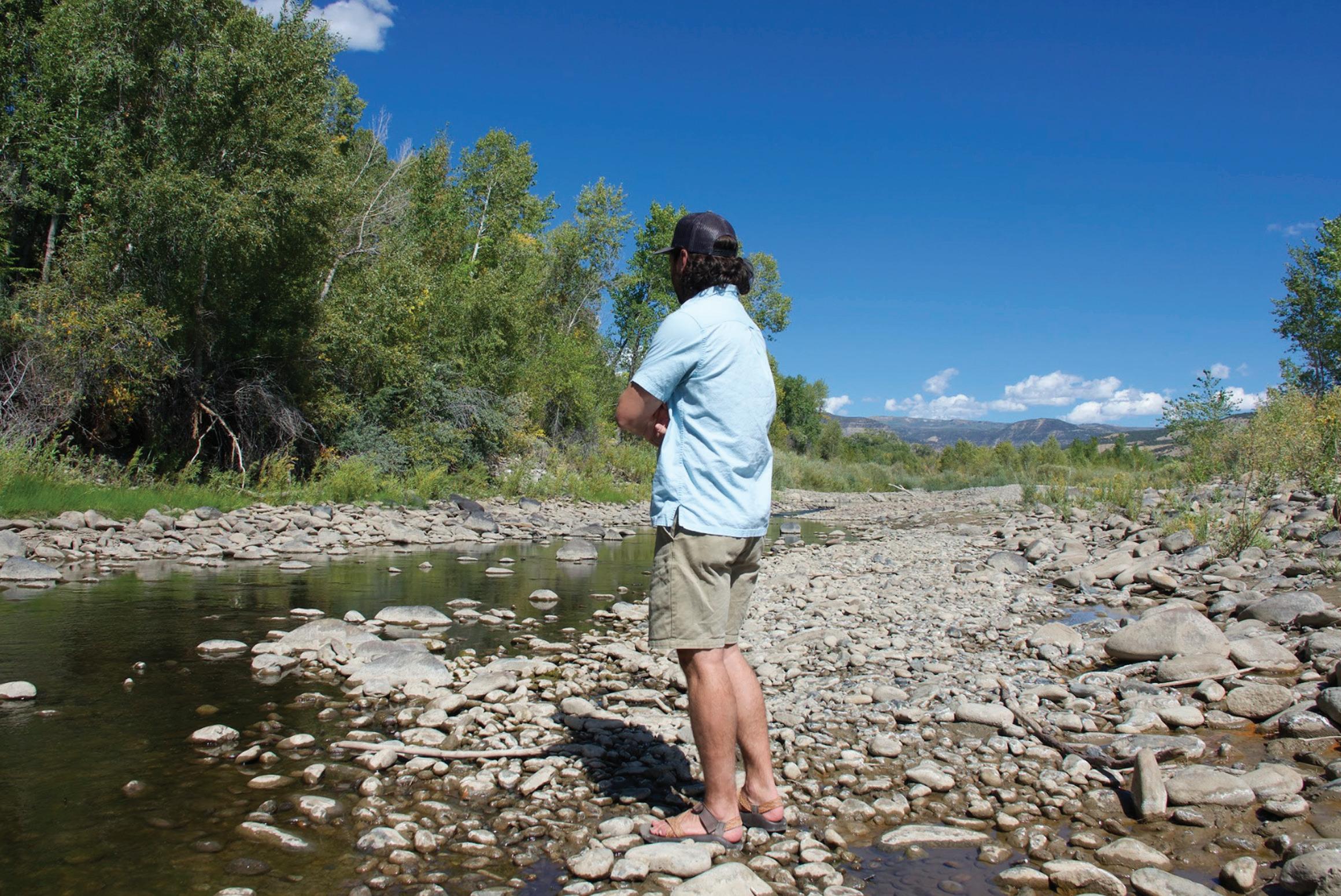
Patrick Dooling, executive director of the West Slope Conservation Center, looks at the Paonia River, which he is worried about from increased resource extraction taking place in the valley.




